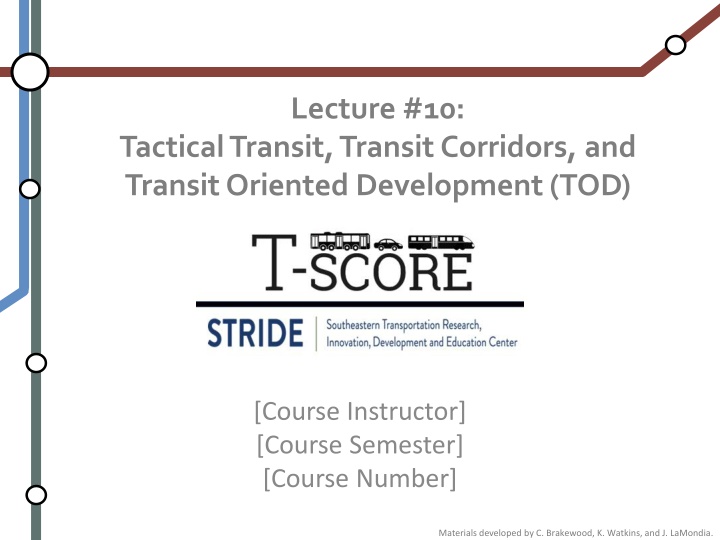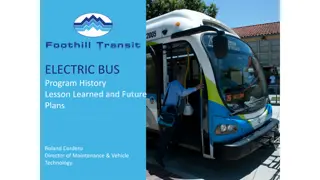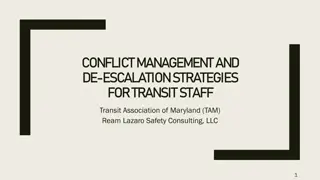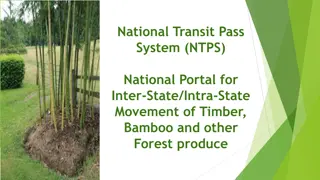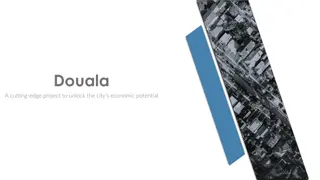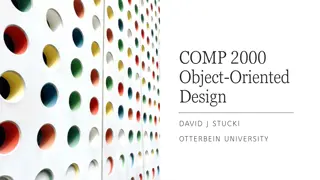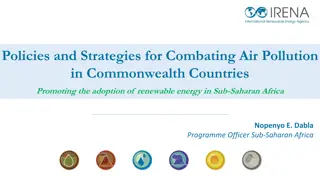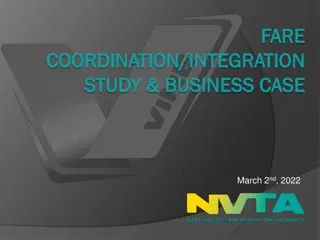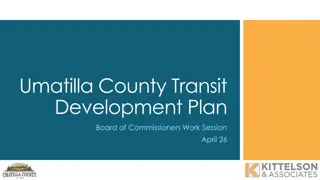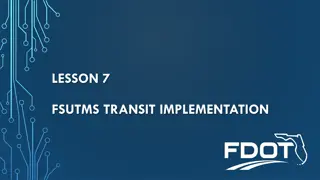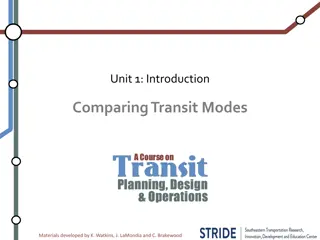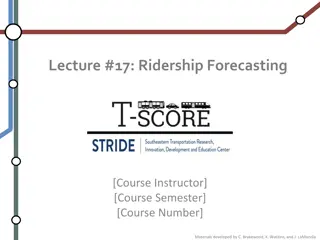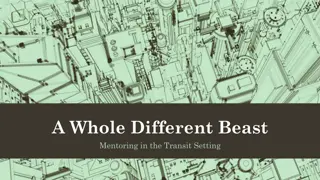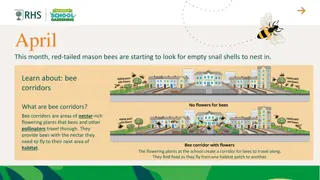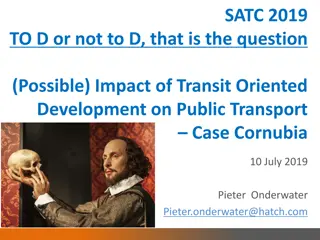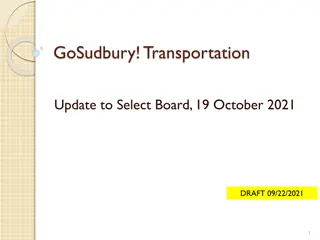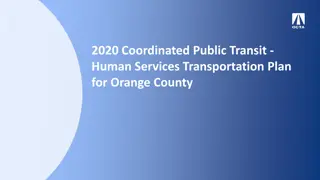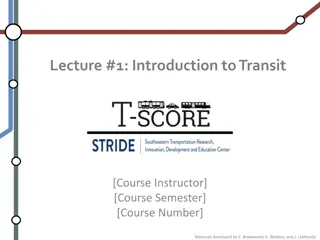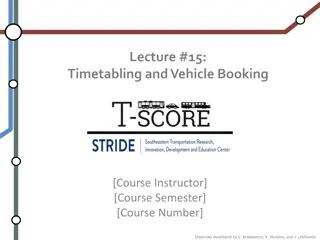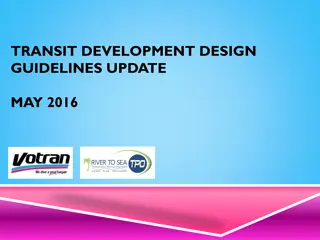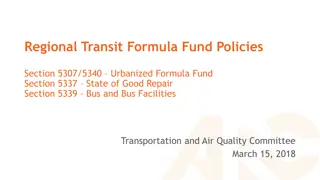Livable Transit Corridors and Transit-Oriented Development
Explore the concept of livable transit corridors and transit-oriented development (TOD) through materials developed by C. Brakewood, K. Watkins, and J. LaMondia. Discover principles, metrics, and best practices for improving livability in transit corridors, including initiating projects, assessing corridors, setting goals, developing visions, and implementing strategies. Learn about the importance of enhancing access to opportunities for improving quality of life along transit corridors.
Download Presentation

Please find below an Image/Link to download the presentation.
The content on the website is provided AS IS for your information and personal use only. It may not be sold, licensed, or shared on other websites without obtaining consent from the author.If you encounter any issues during the download, it is possible that the publisher has removed the file from their server.
You are allowed to download the files provided on this website for personal or commercial use, subject to the condition that they are used lawfully. All files are the property of their respective owners.
The content on the website is provided AS IS for your information and personal use only. It may not be sold, licensed, or shared on other websites without obtaining consent from the author.
E N D
Presentation Transcript
Lecture #10: Tactical Transit, Transit Corridors, and Transit Oriented Development (TOD) [Course Instructor] [Course Semester] [Course Number] Materials developed by C. Brakewood, K. Watkins, and J. LaMondia.
Outline Livable Transit Corridors (TCRP 187) TOD (Reconnecting America) Some recommendations from Jarrett Walker Fast-tracked Projects: Tactical Transit (TCRP 207)
Last class, we talked about Transit Street Design. But how can we plan LIVABLE TRANSIT CORRIDORS? Source: TCRP 187
Definition of Livability People having good access to opportunities they can use in the pursuit of improvements to their quality of life
Transit Corridor Livability Principles & Metrics TCRP 178 Pg. 5
5 Step Best Practice for Improving Livability in a Transit Corridor TCRP 187 Pg.45
5 Step Best Practice for Improving Livability in a Transit Corridor Step 1: Initiate Project establish transit livability stakeholder group, analysis team, project development process, & transit livability definition Step 2: Assess the Corridor evaluate corridor to determine existing livability strengths & needs. Step 3: Identify Goals stakeholder engagement & analysis used to goal set Step 4: Develop a Vision corridor improvement scenarios are identified & analyzed Step 5: Implement Strategies strategies to meet goals identified in Step 3
5 Step Best Practice for Improving Livability in a Transit Corridor Step 1: Initiate Project establish transit livability stakeholder group, analysis team, project development process, & transit livability definition Step 2: Assess the Corridor evaluate corridor to determine existing livability strengths & needs. Step 3: Identify Goals stakeholder engagement & analysis used to goal set Step 4: Develop a Vision corridor improvement scenarios are identified & analyzed Step 5: Implement Strategies strategies to meet goals identified in Step 3
5 Step Best Practice for Improving Livability in a Transit Corridor Step 1: Initiate Project establish transit livability stakeholder group, analysis team, project development process, & transit livability definition Step 2: Assess the Corridor evaluate corridor to determine existing livability strengths & needs. Step 3: Identify Goals stakeholder engagement & analysis used to goal set Step 4: Develop a Vision corridor improvement scenarios are identified & analyzed Step 5: Implement Strategies strategies to meet goals identified in Step 3
Step 3: Identify Goals (3.2.1: Typology Classification) Three basic corridor types 1. Emerging Transit Corridor: serves lower-density, segregated-use communities with limited transit service 2. Transitioning Transit Corridors: on the way to providing high-performing livability conditions but still have room for improvement 3. Integrated Transit Corridors: provide a high level of livability performance. TCRP 187 Pg. 29-30
Step 3: Identify Goals (3.2.1: Typology Classification) TCRP 187 Pg. 31
5 Step Best Practice for Improving Livability in a Transit Corridor Step 1: Initiate Project establish transit livability stakeholder group, analysis team, project development process, & transit livability definition Step 2: Assess the Corridor evaluate corridor to determine existing livability strengths & needs. Step 3: Identify Goals stakeholder engagement & analysis used to goal set Step 4: Develop a Vision corridor improvement scenarios are identified & analyzed Step 5: Implement Strategies strategies to meet goals identified in Step 3
5 Step Best Practice for Improving Livability in a Transit Corridor Step 1: Initiate Project establish transit livability stakeholder group, analysis team, project development process, & transit livability definition Step 2: Assess the Corridor evaluate corridor to determine existing livability strengths & needs. Step 3: Identify Goals stakeholder engagement & analysis used to goal set Step 4: Develop a Vision corridor improvement scenarios are identified & analyzed Step 5: Implement Strategies strategies to meet goals identified in Step 3
Step 5: Strategies for High-Quality Transit, Walking, & Bicycling Opportunities TCRP 187 Pg. 47
Step 5: Strategies for Mixed-Income Housing Near Transit
Step 5: Strategies for Transit Accessible Economic Opportunities TCRP 187 Pg. 48
Step 5: Strategies for Accessible Social & Government Service TCRP 187 Pg. 48
Step 5: Strategies for Vibrant & Accessible Community, Cultural, & Recreational Opportunities TCRP 187 Pg. 49
Step 5: Strategies for Healthy, Safe, & Walkable Transit Corridor Neighborhoods TCRP Pg. 49
Some of the same goals and strategies apply to. TRANSIT ORIENTED DEVELOPMENT (TOD) Source: Reconnecting America
What is Transit Oriented Development? Compact, mixed-use development near transit facilities and high-quality walking environments. - Federal Transit Administration GOAL: Provide sustainable places where people can maximize use of transit systems as part of their work and leisure travel
Some Common TOD Characteristics Centered around rail or bus station High density development within one-quarter to one-half mile Mixed development Shops, schools, public areas, variety of housing types Built with complete streets Streets have good connectivity and traffic calming Parking management policies Convenient and well-designed transit stops and stations Wayfinding and navigation
Careful with Definitions Transit Oriented Development Grid pattern Higher densities Limited surface parking Pedestrian and bicycle designs Mixed housing types Horizontal & vertical mixed uses Office and retail on main streets Transit Adjacent Development Suburban street pattern Lower densities Dominant surface parking Limited pedestrian & bicycle access Mainly single-family homes Segregated land uses Image source: http://seattletransitblog.com/ VTPI reference and Renne 2009
Benefits of TOD Shifts auto trips to transit Promotes walking/ cycling Reduces vehicle ownership Increases accessibility Improves environmental impacts Minimizes transportation costs
Commuting patterns with more transit/bike/walk trips http://www.fta.dot.gov/documents/FTA_Report_No._0050.pdf
Lower vehicle ownership levels http://www.fta.dot.gov/documents/FTA_Report_No._0050.pdf
Challenges Improvements related to self-selection Equity for low-income groups Prior land uses present in area Development companies must support Integration with automobiles
STATION & CORRIDOR LEVEL TOD PLANNING Material from Reconnecting America and the Center for Transit-Oriented Development
Station Level Planning: TOD Place Typologies Regional Centers Urban Centers http://www.reconnectingamerica.org/assets/Uploads/tod202.pdf
TOD Place Typologies Suburban Centers Transit Town Centers http://www.reconnectingamerica.org/assets/Uploads/tod202.pdf
TOD Place Typologies Urban Neighborhoods Transit Neighborhoods http://www.reconnectingamerica.org/assets/Uploads/tod202.pdf
TOD Place Typologies Specialty Use Districts Mixed-Use Corridors http://www.reconnectingamerica.org/assets/Uploads/tod202.pdf
Development Guidelines for TOD Places http://www.reconnectingamerica.org/ assets/Uploads/tod202.pdf
TOD Works Best When Theyre Coordinated http://www.reconnectingamerica.org/assets/Uploads/RA203corridorsFINAL3.pdf
TOD Corridor 1: Destination Connector Links residential areas to multiple activity centers Ridership in both directions Demand for new development in destination stations Pedestrian access is critical http://www.reconnectingamerica.org/assets/Uploads/RA203corridorsFINAL3.pdf
TOD Corridor 2: Commuter Line Links residential areas to one major activity center (CBD) Ridership in one direction Most likely heavy rail system Demand for residential development along corridor Park-and-ride recommended http://www.reconnectingamerica.org/assets/Uploads/RA203corridorsFINAL3.pdf
TOD Corridor 3: District Circulator Travels within a major activity center, a few neighbors Ridership in both directions Requires regional development plan Supports shorter trips May link with other corridor types http://www.reconnectingamerica.org/assets/Uploads/RA203corridorsFINAL3.pdf
LESSONS FROM JARRETT WALKER Human Transit Chapters 5, 14, 15
Lesson 1: Consider the street network in the station catchment area Which is preferable for transit? Walker Chapter 5, pages 60-62
Lesson 2: Transit should be on the way Which is preferable for transit riders? Walker Chapter 5, page 185
Lesson 3: Re-envision boulevards The boulevard of the future Las Vegas, a classic suburban boulevard Walker Chapter 5, page 185
How can we implement transit station and corridor projects faster? TACTICAL TRANSIT Source: TCRP 207
Characteristics of Tactical Transit Implemented on faster timeline than typical capital improvement projects (1-2 years) Impermanent or low-cost materials Smaller budget than typical capital project (less than $100,000) Seeks to build upon the design of infrastructure Short in duration but part of a longer-term effort Accelerates implementation of transportation infrastructure TCRP 207 Summary Pg. 1
Targets of Tactical Transit Projects Speed & Reliability Access & Safety Enhancing Rider Experience
Speed & Reliability Speed & reliability projects addressed transit travel times, improved headways, improved boarding times, & reduced dwell times Typical treatments: dedicated bus/transit lanes, dedicated pre-boarding lanes, operational changes (consolidation, route realignment, queue jump lanes) Study found travel time improvements ranging from 20%-50% (majority from 20%-30%) Also improved car travel times TCRP 207 Summary Pg. 2
Access & Safety Access & safety projects addressed multimodal and ADA access to transit stops & boarding areas Typical treatments: modular boarding platforms, bike lanes, pedestrian infrastructure, road diets, parklets, public space enhancements, & wayfinding Study found projects had 40%-65% reduction in collisions & pedestrian fatalities, increases in ridership up to 17%, & increased bicycle travel ranging from 40%-400% TCRP 207 Summary Pg. 2
Rider Experience Rider experience projects involved improvements to customer experience pre- and post-boarding Typical enhancements: improved seating, improved furnishings, public art, design competitions, wayfinding, & public space TCRP 207 Summary Pg. 2
Speed & Reliability Broadway Bus Lane: Everett, MA Broadway Bus Lane: Everett, MA cones along a 1 mile stretch of Broadway created a dedicated bus lane in peak hours (4AM-9AM) So successful that the lane was made permanent 9 months later Transit saving times of approximately 6 minutes (20%-30% reduction) TCRP 207 pdf Pg. 62
Broadway Bus Lane: Everett, MA Initial Implementation TCRP 207 pdf Pg. 63
